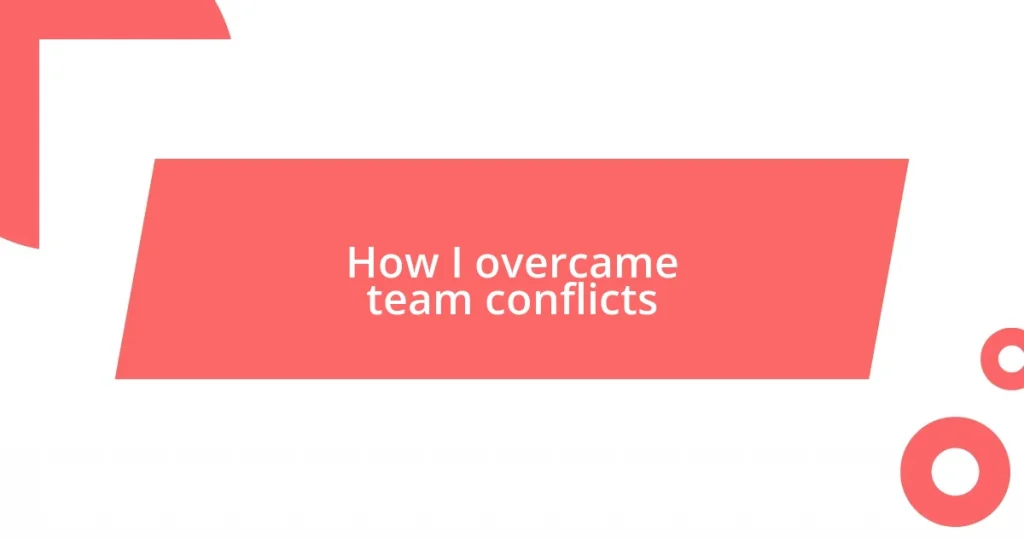Key takeaways:
- Conflicts often arise from communication breakdowns, differing values, and emotional dynamics, making clear communication essential for team harmony.
- Implementing effective communication strategies, such as open discussions and active listening, can transform misunderstandings and strengthen relationships within teams.
- Creating a collaborative environment through trust, diversity, and proactive conflict resolution fosters a culture of support and minimizes future disputes.
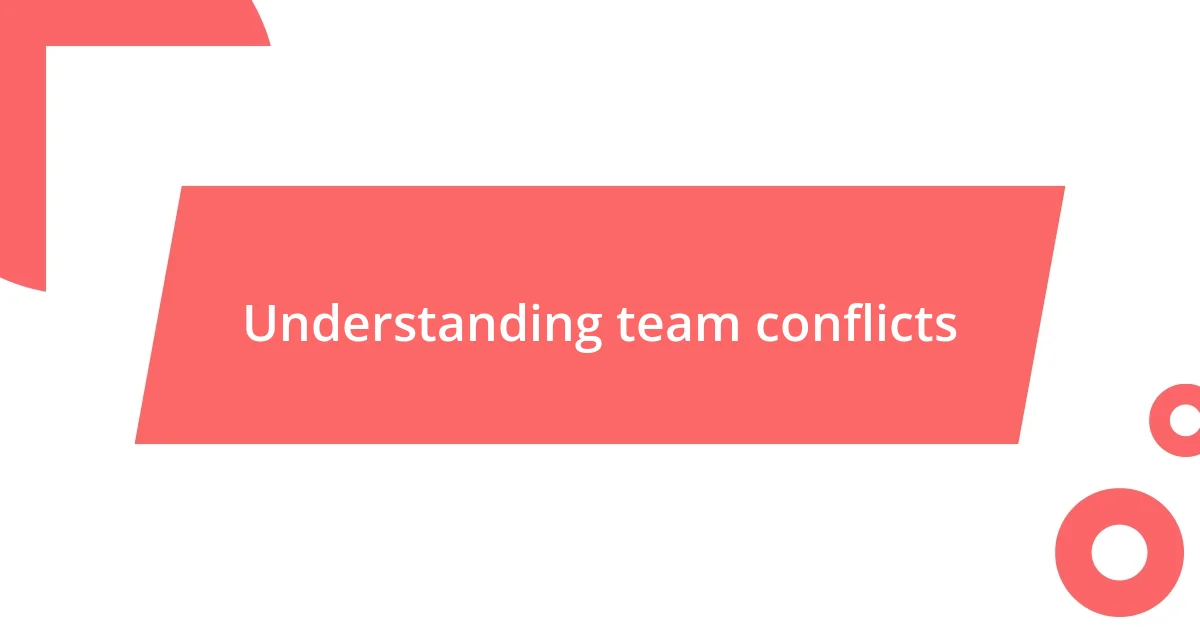
Understanding team conflicts
Team conflicts often arise from a clash of personalities, differing values, or unclear communication. I remember a project where one team member, passionate about their ideas, unintentionally sidelined others. Have you ever witnessed someone dominate discussions, leaving others feeling undervalued? It’s tough to watch, and it can really disrupt team harmony.
In my experience, conflicts can also stem from unmet expectations. Once, I assumed everyone was on the same page regarding our project deadlines, but it turned out we had very different interpretations. This misalignment led to frustration. I often wonder – how many misunderstandings could be avoided with clearer communication?
Moreover, emotional dynamics play a significant role in how conflicts manifest within teams. I recall feeling anxious when tensions rose in team meetings. It made me question my contributions and whether I truly belonged. Recognizing that emotions like fear or frustration can fuel conflicts is crucial in navigating through them. Have you noticed how acknowledging these feelings can change the atmosphere entirely?

Identifying conflict sources
Identifying the sources of conflict within a team is crucial for resolution. I’ve experienced firsthand how mixing different work styles can lead to misunderstandings. A friend of mine, who preferred a structured approach, struggled with another team member who thrived in flexibility. Their approaches clashed, creating an atmosphere full of tension. It made me realize that examining the underlying causes of such friction is essential to find common ground.
When I reflect on my own experiences, I find several key sources of conflicts that often emerge:
- Communication breakdowns: Misinterpretations can occur easily when team members have different communication styles.
- Diverse values and priorities: What one person prioritizes, another might not value, leading to differing opinions on important issues.
- Role ambiguity: Unclear roles can mean people step on each other’s toes or avoid taking responsibility altogether.
- Personal stressors: External factors affecting team members can spill into the workplace, influencing their interactions and perceptions.
Recognizing these sources not only helps address current conflicts but can also prevent future issues from arising. It’s a small step that can lead to much larger improvements in team dynamics.
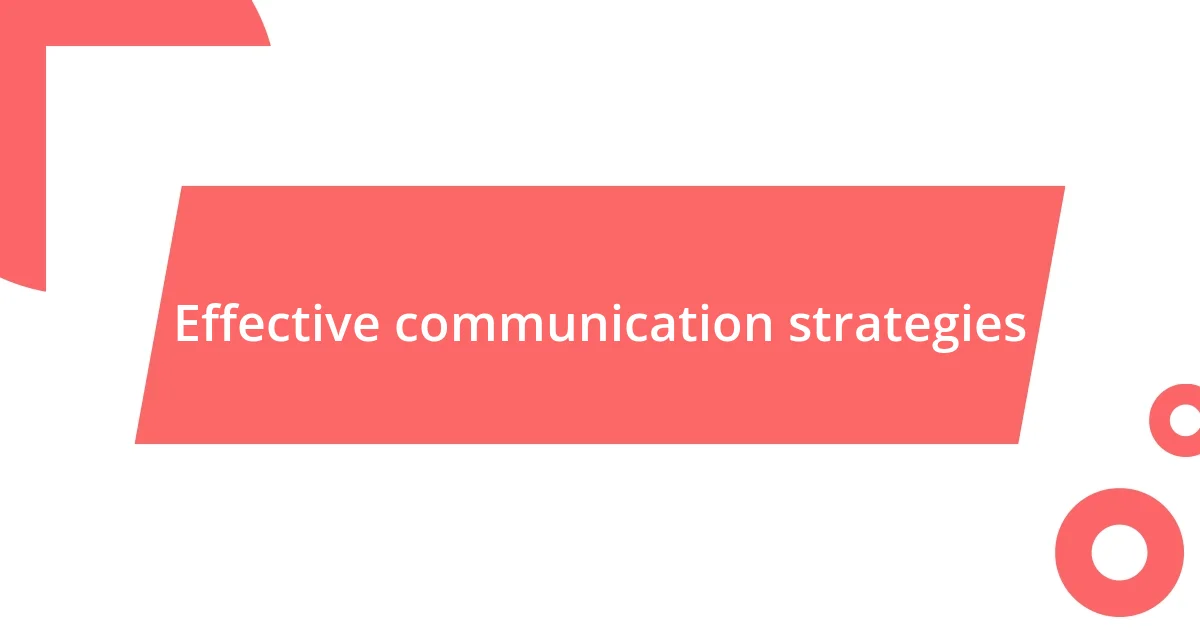
Effective communication strategies
Effective communication can be the lifeline of any team navigating conflicts. In one of my previous teams, we faced a significant misunderstanding regarding project expectations. After a candid conversation where I encouraged everyone to share their thoughts, it became clear that we all held different interpretations. This simple act of open discussion transformed our project workflow and strengthened our relationships. Have you ever felt that moment when clarity washes over the group? It’s truly liberating.
I have also found that active listening plays a vital role. It’s not just hearing what others say but engaging with it. During a heated debate, I made it a point to summarize what each team member expressed before responding. This not only showed them that I valued their opinions but also created a space where everyone felt heard. Such validation can be a game changer in dissipating tension. When was the last time you felt truly listened to? I suspect it might have changed the way you felt about the situation.
Incorporating regular check-ins has proven beneficial for maintaining clarity and camaraderie. After experiencing a particularly challenging project, I initiated brief, weekly catch-ups where everyone could voice any issues. It fostered a culture of support and transparency, significantly minimizing stress and misunderstandings. I often think about how a few minutes each week significantly impacted our collective morale. How often do you pause to check in with your team?
| Communication Strategy | Description |
|---|---|
| Open Discussion | Encourages team members to express differing views, fostering understanding. |
| Active Listening | Engages with what others say, making them feel valued and understood. |
| Regular Check-ins | Provides a platform for ongoing dialogue, addressing issues before they escalate. |
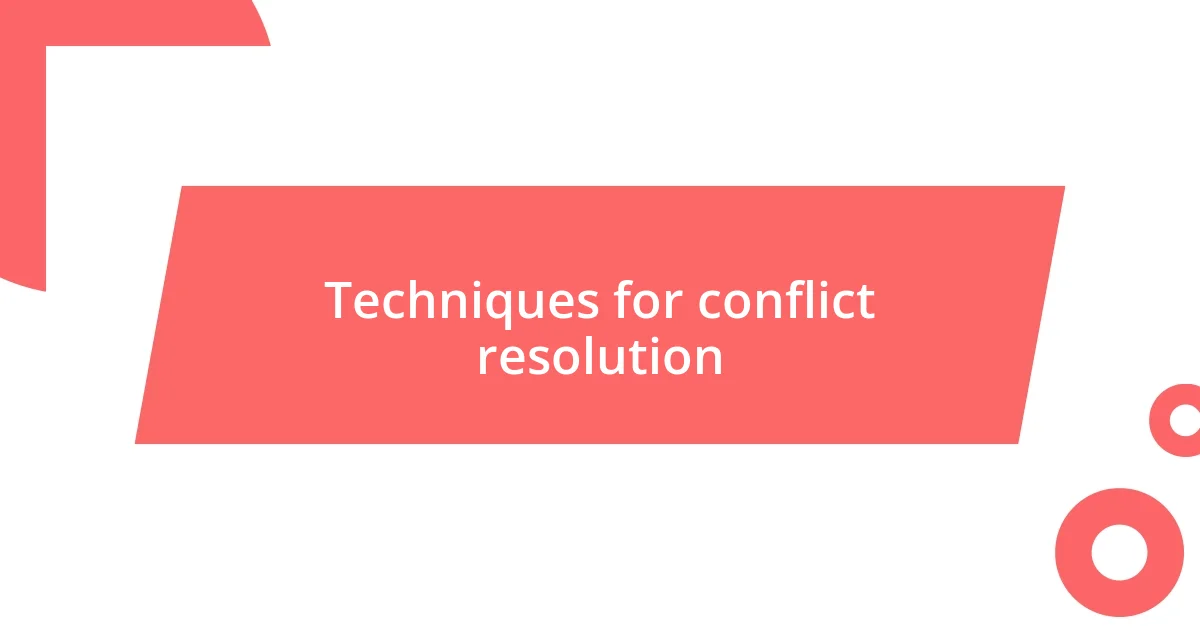
Techniques for conflict resolution
In my experience, mediation can be a powerful technique for resolving conflicts. When tensions escalated in one of my projects, I suggested bringing in a neutral third party who could facilitate a conversation. This person helped guide us through a structured dialogue where we could express our viewpoints without interruption. I realized how vital it was to have someone to keep the conversation on track—have you ever noticed how easy it is to drift off-topic when feelings run high?
Another strategy I found effective is collaborative problem-solving. I once worked alongside a colleague who felt sidelined during decision-making processes. Instead of brushing this aside, I proposed that we brainstorm solutions together. What struck me was that, as we started co-creating our path forward, not only did our relationship improve, but we also came up with a more innovative approach than I had initially thought possible. Have you tried involving conflicting parties in the solution rather than dictating terms?
Lastly, establishing ground rules for respectful dialogue can truly transform how conflicts are handled. In a past team meeting that turned into a heated debate, we agreed beforehand that everyone would speak without interruption and avoid personal attacks. I remember feeling a palpable shift in the room—suddenly, the focus moved from winning an argument to genuinely understanding one another. It made me wonder—what simple agreements could your team implement to foster a more positive conversation? The ease with which respect could diffuse tension reminded me that sometimes, a little structure can go a long way.
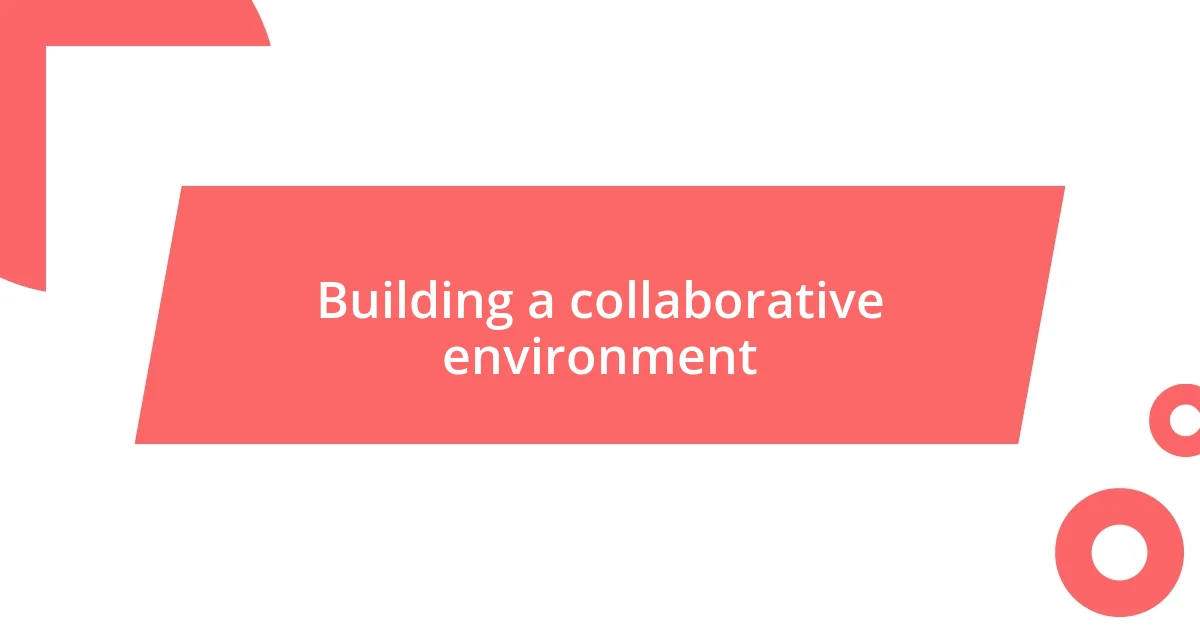
Building a collaborative environment
Creating a collaborative environment requires intentional actions and an open mindset. In my last project, I organized team-building activities that seemed a bit cliché at first, but to my surprise, they brought us all closer together. I observed that when colleagues started to share laughs and personal stories, the barriers dissipated. Have you ever noticed how a little fun can transform a group dynamic?
Trust is the cornerstone of collaboration. I’ve learned that by being transparent about my own challenges, I encouraged others to open up. During a tough phase in our project, I shared my struggle with meeting deadlines, which led to a frank discussion about everyone’s hurdles. This level of vulnerability sparked a culture where admitting difficulties was met with support rather than judgment. Isn’t it fascinating how leading by example can shape an entire team’s ethos?
Additionally, embracing diversity can vastly enrich a collaborative environment. On one occasion, I led a team with members from various backgrounds, and we made a point to celebrate our differences during meetings. Each unique perspective added depth to our discussions, encouraging innovative problem-solving. I still remember how one team member’s unconventional approach turned a stuck project around. It made me think—how often do we underutilize diverse viewpoints in our quest for collaboration?

Learning from conflict experiences
I often think about the moments when conflict pushed us to grow. In one specific instance, our team faced a significant disagreement about project direction. Instead of avoiding it, I initiated a feedback session where each person could share their concerns openly. What surprised me was that this seemingly daunting task turned into a learning experience. By addressing our differences directly, we not only clarified our goals but also deepened our respect for each other’s opinions. Have you ever noticed how conflict can be a catalyst for reflection and understanding?
Reflecting on conflicts reveals valuable insights. After working through a particularly tense situation involving miscommunication, I took the time to journal about what unfolded. I discovered patterns in my own reactions and realized how my assumptions could lead to misunderstandings. This self-awareness became crucial for future interactions, reminding me to approach potential conflicts with curiosity rather than defensiveness. How often do we take the time to reflect on our role in conflicts, rather than just pointing fingers?
Learning from conflict experiences doesn’t just stop with the immediate resolution. I remember a time when a disagreement nearly derailed our project timeline, but it ultimately taught us the importance of proactive communication. From that point on, we agreed to check in regularly, addressing potential issues before they escalated. Looking back, it’s clear that what felt like a setback became a stepping stone towards a more cohesive and proactive team. Isn’t it interesting how conflicts can shape our future strategies if we let them?

Preventing future conflicts
Fostering a culture of open communication is essential in preventing future conflicts. In one of my earlier teams, we implemented a weekly “check-in” meeting where everyone could voice concerns, share updates, and celebrate small wins. I noticed that this routine not only kept us aligned but also built a sense of belonging—like we were all part of something bigger. Have you ever felt the relief that comes from simply being heard?
Setting clear roles and responsibilities also plays a pivotal role in minimizing misunderstandings. Early in my career, I once dove into a project without explicitly defining our individual tasks. As a result, we ended up stepping on each other’s toes, leading to friction and frustration. From that experience, I learned to clarify responsibilities at the project’s outset. I now firmly believe that it’s the little things—like clearly articulated roles—that can save a team from potential chaos down the line.
Moreover, cultivating emotional intelligence within the team can transform how we handle disagreements. I recall a time when one of my colleagues reacted strongly during a meeting. Instead of dismissing those emotions, I encouraged us all to pause and decompress. This moment of reflection changed the tone of our discussion, allowing us to approach the situation with empathy. Don’t you think it’s vital to recognize that behind every conflict is a person with emotions and experiences?










